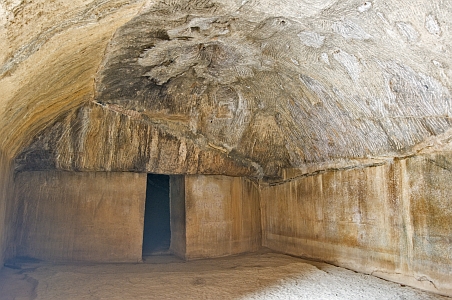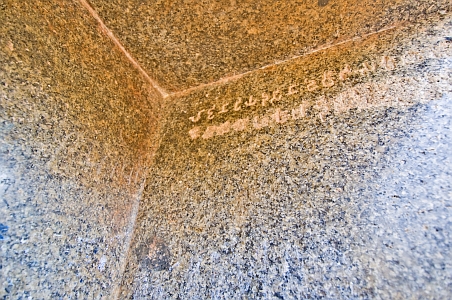A Passage To India - Location-Notes, Photos, and Maps of the Barabar Caves near Gaya, Bihar (original) (raw)
The Barabar Caves - 4: Inside the Lomas Rishi Cave
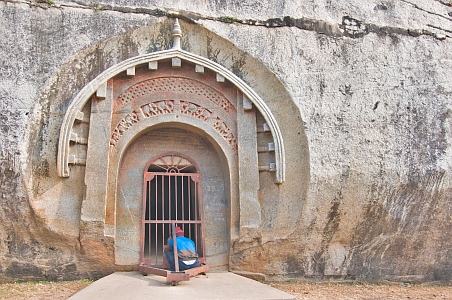
Unlocking gate to the Lomas Rishi Cave
The most famous of all the caves at Barabar is the Lomas Rishi Cave, due to the ornate carved arch that surrounds the exterior entance to the passageway. The cave is dated at c. 450 - 300 B.C. It is the first available example of famous Buddhist Chaitya arch style in India. Examining the detail of the carving, we see a curved and pointed arch, supported with mock corbelling. The shape of the arch is reminiscent of the curve used on Buddhist stupas, which themselves reflect the natural shape of the Bo or Bhodi Tree's leaf. This tree was the one under which the Buddha was meditating when he acheived enlightenment. Beneath this is a carved lattice-work panel, bordered on both sides by carvings that show tied bundles of leaves. Beneath that are shown ten elephants, paying homage to three Buddhist stupas. A circular arch below that is followed by six lines of Ashokan text, accredited by some to the Ajivikas, whose founder, Makkhali Gosala, was a contemporary of Buddha.
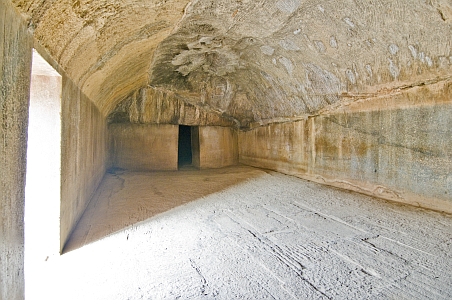
Interior of the Lomas Rishi Cave, looking towards inner sanctum
After such an imposing entrance, the interior of the Lomas Rishi Cave is thus rather a disappointment. Though a similar size inside to the Sudama cave, and having the same arrangement of inner and outer sanctums, the inside has been left with a very rough finish, nothing like the smooth, glass-like surface in the Sudama cave. Why was this? The cave had obviously taken a huge effort to carve out, and presumably the same effect of its echo was hoped for.
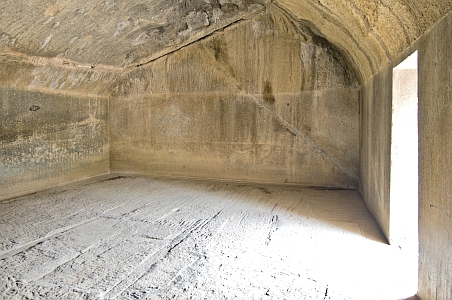
Lomas Rishi entrance wall with rock fissure
For me, the clue to an answer for this question comes when looking at the end wall to the right of the entrance, as you enter the cave. As can be seen from the photograph above (Click it to show a bigger image in new browser window), the end wall has a huge diagonal crack in it, that meets another crack that runs between the wall and roof, then travels left to the rest of the cave. Were these cracks found in the rock whilst the carving was taking place? Were they caused by the rock shifting after so much beneath had been removed? Perhaps the cracks occured later, due to earthquake or similar natural catastrophe?
These questions could, no doubt, be answered by a trained geologist. Unfortuately, I am not one. Whatever the cause, though, the result would have been the same. The workmen quickly realised that with cracks such as these in the cave structure, it would be impossible to achieve the same acoustic perfection as was attained in the Sudama cave.
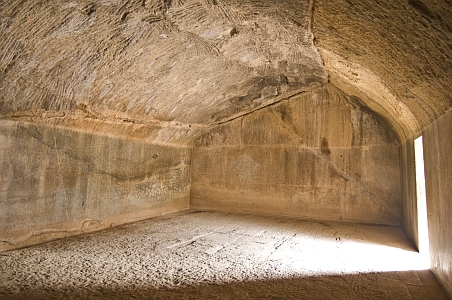
Interior of the Lomas Rishi Cave, looking towards entrance
They thus either left the work as was when the discovery was made, or crudely finished the job to give an approximation of the intended shape and size. Even if the Lomas Rishi Cave could not be used for chanting and meditation, it could still be used for other religious ceremonies, accomodation, or storage. With such a fine entrance portal, it was impossible for the cave to be abandoned or destroyed.
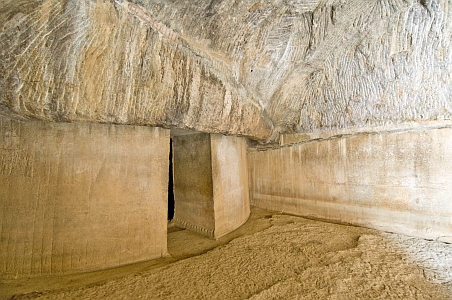
Innner sanctum doorway showing passage depth
Although the cave was never completed to the same stage of perfection as the Sudama cave, we still have something of interest to study. The rough state of the ceiling gives valauble clues about the type of tools used by these early masons, and their state of sharpness. It also shows the way that such large areas were prepared for clearing, and gives hints about the typical techniques used to level and finish both flat and curved surfaces.
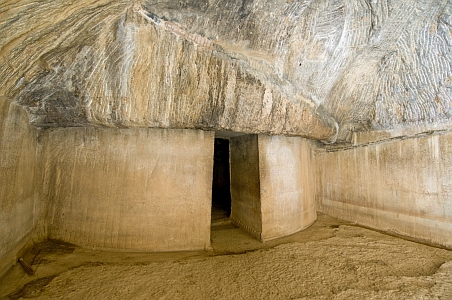
Showing curve of the inner sanctum wall
Looking at the photograph showing the entrance passage to the Lomas Rishi cave, we can see that it has been properly finished, and compares well to the entrance passages of both Karan Chopar and Sudama caves. The floor of the passage has a slightly rough, tooled surface that would be useful to stop slipping in wet weather. The walls, meanwhile, have been smoothed to a high level. If people outside of the religious order who supervised the caves were not allowed into the Lomas Rishi, they would never know that the interior was not finished to a similar state as the others, and thus prestige would be maintained.
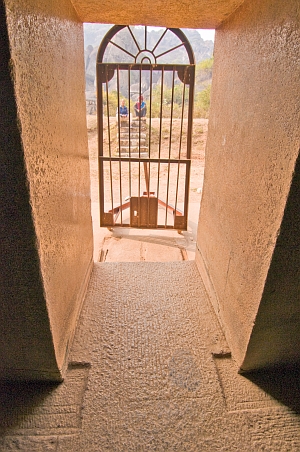
Lomas Rishi entrance passage and floor-detail
At the inside of the passageway, at floor level, two rectangular channels have been cut, slightly below the level of the floor. I can only guess at the reason for these channels, so if any reader has a more informed suggestion, I would be grateful to hear it.
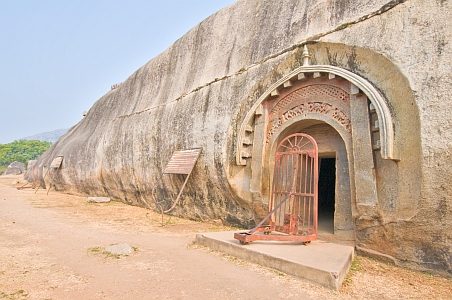
Lomas Rishi doorway, with Sudama entrance to far-left
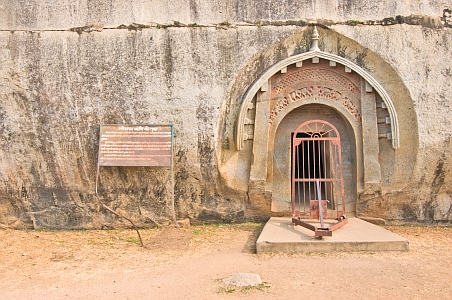
Entrance to the Lomas Rishi Cave at Barabar
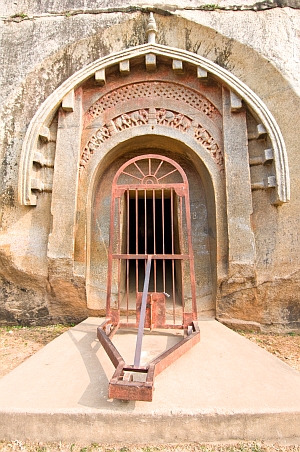
Entrance to the Lomas Rishi Cave
Readers may be interested to note that the photographs on Barabar pages 2-10 are all available for licensing as high-resolution images. Please Contact Me if you wish to discuss any images that you are interested in licensing.
The photographs mentioned have the following technical specification:
- Captured in 14bit Raw format at the D300's maximum resolution of 12.3Mega pixels.
- Corrected after RAW conversion, if necessary, in PhotoShop 16 bit mode.
- Converted and saved as 300ppi 8 bit Tiffs in Adobe RGB (1998) colour space.
- Image Compression set to NONE when saving as TIFF.
- Free from sensor dust spots.
- Flattened, no Layers or Alpha Channels.
- Displayed with correct orientation.
- Image size 4288 x 2848 pixels, or similar.
- Minimum Tiff file size of 28MB.
- No images have been sharpened - can be performed by the end user if required.
Please visit Page 5 of the Barabar Cave series..
Web design by MapAbility.com :: All rights reserved :: All images and pages on this site, unless otherwise mentioned, are © 2004 - 2024 by Tim Makins

